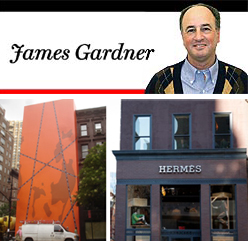Trending
Hermès incarnation is a gift to Madison Ave.
 From left: the new Hermès store at 690 Madison Avenue during its renovation and after
From left: the new Hermès store at 690 Madison Avenue during its renovation and afterFor months the façade of 690 Madison Avenue was under wraps, but the identity of the creature beneath the elaborate chrysalis was hardly in doubt: the store, after all, was covered in what looked unmistakably like a massive orange Hermès gift box. The gift was unveiled and Madison Avenue is the better for it — the first Hermès store for men.
A turn-of-the-century townhouse in a landmark district formerly occupied by the Italian haberdasher Luca Luca has been fundamentally transformed. For starters, it used to be white, with marble rustication climbing up to the cornice over the second story. Now it is decked out in dark stone cladding up to the same height, and thereafter the white paint has been peeled off to reveal the original red brick.
In truth, the relation of the lower part of the five-story Building Near 62nd Street to the upper part is not especially well managed, as it had not been in the building’s previous incarnation. But that’s alright since New Yorkers tend not to raise their sights above the second floor anyway, and since the intent of the cornice, after all, was visually to divorce the lower part of the building from the upper part.
Meanwhile, the broad, pumpkin-colored windows of Luca Luca have yielded to far narrower glass strips that allow the masonry to reassert itself, and the angled corner of the old store has been squared off once again.
Inside, the space feels surprisingly small, having been artificially delimited by all the interior wall work. The lighting is muted and hushed, the accents are of dark wood, and the floors abound in gray carpeting and pale tiles defined by a woven motif.
The total effect is the very opposite of the company’s flagship store, directly across the street at 691 Madison. There a late Art Moderne palace by McKim Mead & White was sumptuously transformed by Beyer Blinder Belle in the 1980s, until it was ablaze with glass walls and an overarching skylight, not to mention a sculpted knight on horseback inexplicably strapped to the roof.
James Gardner, formerly the architecture critic of the New York Sun, writes on the visual arts for several publications.




